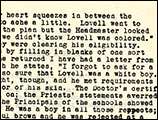The Civil Rights Movement in Florida
Teacher’s Guide for Education and Jim Crow
Background Information
The letter included here is an artifact from the age of Jim Crow; an era of legal segregation characterized by violence and discrimination against African-Americans. The author of the letter, Florence Lovell Roane, was a professor of English at Bethune-Cookman College in Daytona.
Her son Lovell was accepted to a college preparatory school in Niagara Falls, New York, based on glowing recommendations from his pastor, physician, and school principals. When he arrived, he was denied admittance on account of his race.
The headmaster of the school explained to his mother: “I forgot to ask for a picture because I was so sure that Lovell was a white boy.”
Professor Roane goes on to describe her son’s trip. “At Niagara Falls he saw the soft bed in the room set aside for him. He ate at the table they had planned for him. He tried on the cadet uniforms they had planned for him to wear. He looked at me in Fessenden and said, ‘Oh Mother, you should have seen those lovely beds at DeVeaux; I just wanted to sleep there one night.’”
Roane wrote this letter to Daniel M. Williams to convey her disappointment. At the time, Williams was at work on a biography of educator and civil rights leader Mary McLeod Bethune.
Roane told Williams that her son Ernest Lovell Dyett was upset after being turned away from Deveaux College. She explained that her son would attend Fessenden, an African-American preparatory school near Ocala, Florida. Lovell later graduated from Bethune-Cookman College and Harvard University. He went on to have a distinguished career at Howard University and in broadcasting.
Roane came to Daytona in 1934. She held a Ph.D. in education from Boston University. Because of staff shortages alluded to in the letter, Roane was serving as Bethune’s secretary in addition to her teaching duties. She retired from Bethune-Cookman in 1979.
Until the landmark U.S. Supreme Court ruling in Brown v. Topeka, Kansas Board of Education (1954), most educational facilities, both north and south of the Mason-Dixon Line, clung firmly to racial segregation. This was especially evident in primary and secondary schools.
This letter demonstrates that no matter the potential of an individual, Jim Crow laws and other means of de facto legal segregation prevented African-Americans from equal access to education. As demonstrated in the case of Florence Lovell Roane and Ernest Lovell Dyett, discrimination did not stop many African-Americans from achieving their personal and professional goals.
Use to Illustrate:
- Discrimination in education.
- African-American access to education during the Jim Crow era.
- Barriers to equality in education.

 Listen: The Assorted Selections Program
Listen: The Assorted Selections Program
